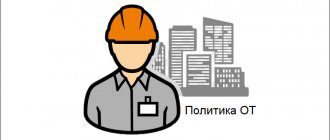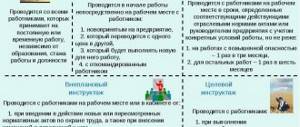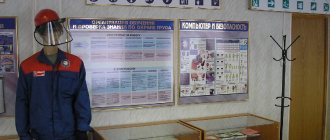07.09.2019
0
47
3 min.
When applying for employment in a company, the employer and the citizen applying for a vacant position sign an agreement in writing. From this moment on, the employer must provide comfortable working conditions for the employee, and he is obliged to perform his functions efficiently and in a timely manner. In particular, an employer with an organization employing more than 50 people must introduce a labor protection service into the current schedule.
Labor protection service in the organization
To study the procedure for creating, functioning and abolishing a structure involved in protecting the professional activities of employees, it is necessary to study Article 217 of the Labor Code of the Russian Federation. When signing an employment agreement, employers and applicants need to know the laws and subsequently comply with mutual written agreements. An employee who works and does not violate labor safety rules receives a salary, and the manager pays it on time and in full. The norm regulating the actions of employers to comply with the rules of protection of professional activities is Article 217 of the Labor Code of the Russian Federation.
Concept of labor protection service
This structural unit must be present in companies where the staff number exceeds 50 people. In this case, the organizational and legal form does not matter. This may be a legal entity or an individual entrepreneur. At the beginning of a professional relationship, people are required by law to enter into a written employment contract. It also stipulates the rights of working people in the field of labor protection. Employees have the right to work in conditions that meet all safety standards.
The manager must also comply with the special rules for special categories of employees prescribed in Art. 224 Labor Code of the Russian Federation. Let's list what is required from employers:
- limit the involvement of certain categories of employees in certain types of work, night work, and overtime;
- transfer people who, due to physical health reasons, need to be offered another job, to other positions according to their capabilities, with proportional wages or tariffs;
- arrange periods for rest;
- create specific conditions for professional activity for people with disabilities.
Main functions
A structural unit that ensures normal working conditions in the organization, in accordance with Art. 217 of the Labor Code of the Russian Federation, performs the following tasks:
- Ensuring that employees comply with labor safety regulations.
- Monitoring employees' compliance with labor safety rules and all regulations governing this part of their professional activities.
- Prevention of injuries at work and diseases arising from professional activities.
- Informing employees of the organization on compliance with labor safety rules.
- Promotion of safe activities, especially in conditions dangerous to the health and life of people.
Composition, qualifications of participants, location
The structure and number of service employees is determined by the head of the organization. His orders should not contradict what is dictated by the Labor Code Article 217, the requirements of the executive state body exercising regulatory and supervisory functions in the field of labor activity.
The following applicants are usually considered for the position of an employee working in the labor protection department:
- with experience as a labor protection engineer in other organizations,
- with special higher education.
If an applicant for a vacant position has only a secondary vocational education, but has worked in a position, for example, as a first category technician for at least three years, then he may also be considered for an open vacancy in the company.
Attention! All occupational safety specialists must undergo professional training in the organizations where they are hired for the relevant positions. Control over the activities of a specialist or occupational safety service is exercised by the company’s chief manager or an entrepreneur if he works for himself.
Employees always bear individual responsibility for the performance of their immediate duties as provided for in their job description. In case of violation of internal documents, employees are subject to punishment in accordance with administrative and criminal legislation.
In what case is it created
The main requirement is that in enterprises with more than 50 employees it is mandatory to create it, and with a smaller number of employees, a structural unit is included in the staff by decision of the head of the organization. This is stated in Federal Law No. 90 of June 30, 2006.
In what case is it not necessary?
If the number of the company is less than 50 people and the employer does not consider it necessary to add a labor protection specialist to the staff, then a similar structural unit is simply not created. The responsible person for compliance with the conditions for carrying out professional activities is the head of the enterprise. He performs the necessary functions, even if he is a private businessman.
Working conditions
We will describe in detail what regulatory documents on labor protection include:
- formulated requirements for protecting working conditions;
- professional responsibilities before starting work, during it and at the end of the day;
- procedure for emergency situations (calls, messages, actions).
The employee’s responsibilities in terms of labor protection are the object of close attention from the employer. Failure to comply will result in disciplinary action being taken against the current employee.
Article 209.1 Basic principles of occupational safety
This is a new article that is not in the old edition. Here is its content:
The basic principles of ensuring occupational safety are:
- warning and prevention of hazards;
- minimizing damage to workers' health.
The principle of warning and prevention of hazards means that the employer must systematically implement measures to improve working conditions, including eliminating or reducing levels of occupational risks or preventing their levels from increasing, while respecting the priority of the implementation of such measures.
The principle of minimizing damage to the health of workers means that the employer must provide measures to ensure constant readiness to localize (minimize) and eliminate the possible consequences of occupational risks.
The priority of implementing measures to improve working conditions, eliminate or reduce levels of occupational risks or prevent their levels from increasing is established in the indicative list specified in part three of Article 225 of this Code.
I skip Article 210 - Main directions of state policy in the field of labor protection and Article 211 - State management of labor protection. You will know them by their actions, as they say.
Want to know what safety legislation changes have occurred in 2021? Come to our online conference! Participation is free.
New articles 211.1, 211.2, 211.3 specify the powers of the Government, Federal executive authorities, executive authorities of constituent entities in the field of labor protection. Also on business.
Proceedings in civil courts
Civil case about violations of Art. 217 of the Labor Code is brought to court only on the grounds of causing harm to human life and health. A lawsuit is filed. The main evidence is:
- decisions of supervisory authorities;
- court decision on bringing to administrative liability;
- verdict in a criminal case.
If a final decision was not made in the last two categories of cases, or the court terminated the proceedings due to the expiration of the statute of limitations, or the criminal case was also terminated and no verdict was rendered, a civil lawsuit is filed. However, in such a situation it is more difficult to win the case.
The judge will evaluate the materials provided, the guilt of the enterprise and the plaintiff, if this is indicated in the objection to the claim.
If a verdict of innocence is pronounced, or the investigator dismisses the case due to the lack of guilt of the owner of the enterprise and his officials, or the court refused to bring them to administrative responsibility due to their innocence, the civil claim will be considered unfounded.
Challenging a fine
If the case has already been brought to court and, according to the Code of Administrative Offenses, a fine was imposed on the enterprise for violating labor safety rules, an appeal is made in the manner prescribed by the Code of Administrative Offenses.
For example, an order was issued for violation of the instructions and its frequency. It is appealed in accordance with the CAS procedure by filing a claim.
If the labor inspectorate considered that the order was not fulfilled and sent the materials to the court with an additional act, the proceedings are carried out within the framework of the Code of Administrative Offenses.
It should be noted that a fine or other administrative punishment is imposed only by the court.
Legislative regulation
Art. 217 of the Labor Code serves as the basis for legislative regulation of labor protection. The main act is the specialized law on labor protection.
The organization of the labor protection service is described in a special recommendation of the Ministry of Labor. It applies to all sectors of the economy.
The status of a recommendation means that the head of an enterprise or individual entrepreneur has the right to adhere to its provisions to the extent they deem necessary. However, in practice, their precise application will serve as a defense against claims from government regulators.
Also, many GOSTs, other recommendations, and rules have been published that in one way or another relate to safety rules at the enterprise.
Thus, legislative regulation is provided for the most part not by the norms of the law, but by a whole complex of by-laws, some of which are formally recommendations, and not a set of mandatory rules.
This situation complicates the application of Art. 217 Labor Code of the Russian Federation.
Article 214.1. Prohibition of work in hazardous working conditions
The employer is obliged to suspend work at workplaces in cases where the working conditions at such workplaces, based on the results of a special assessment of working conditions, are classified as a dangerous class of working conditions.
Work is suspended until the grounds that led to the establishment of a dangerous class of working conditions are eliminated.
During the suspension of work at the workplaces specified in part one of this article, employees employed in such workplaces are provided with the guarantees established by part three of Article 216.1 of this Code.
Elimination of the grounds that led to the establishment of a dangerous class of working conditions is carried out on the basis of an action plan that is developed by the employer, taking into account the opinion of the elected body of the primary trade union organization or other representative body of workers (if any).
A copy of the action plan approved by the employer is sent by the employer to the territorial body of the federal executive body authorized to conduct federal state supervision over compliance with labor legislation and other regulatory legal acts containing labor law norms at the employer’s location.
The resumption of the employer's activities at the workplaces specified in part one of this article is allowed only based on the results of an unscheduled special assessment of working conditions, confirming a reduction in the class of working conditions.
The prohibition established by this article does not apply to work related to the prevention or elimination of the consequences of emergency situations, as well as to certain types of work, the list of which is approved by the Government of the Russian Federation, taking into account the opinion of the Russian Tripartite Commission for the Regulation of Social and Labor Relations.
How to calculate the number of OSH service employees at an enterprise
The total standard number of employees of the labor protection service (HR) is calculated in accordance with clause 4 of the Intersectoral Standards using the formula:
Chnsot = Chst1 + Chst2 + … + Chst8,
Where:
Subscribe to our newsletter
Yandex.Zen VKontakte Telegram
Chst - the number of employees of the labor protection service, determined from tables 1–8 contained in subparagraphs of clause 3.2 of the Interindustry Standards, depending on the production factors reflected in the statistical reporting.
The list number of employees of the OT service (Chssot) is determined by the following formula:
Chssot = Chnsot × Kpr,
where Kpr is a coefficient that adjusts the number of service employees taking into account their absence from work due to illness, vacation or other circumstances.
The Kpr indicator is calculated using the formula:
Kpr = 1 + Ppr / 100,
where Ppr is the percentage of absences from work according to accounting data.
At the same time, the payroll and staff numbers of employees of the OT service are equal.
Disputes with supervisory authorities
Judicial practice under Art. 217 of the Labor Code of the Russian Federation is represented by various cases, in particular:
- challenging decisions of the labor inspectorate;
- bringing enterprises and officials to administrative liability;
- recovery of material and moral damage in connection with harm to the life and health of an employee.
In what form of legal proceedings are cases considered?
If we are talking about appealing decisions for violation of Art. 217 of the Labor Code, the application of the CAS and the Code of Administrative Offenses should be separated.
Claims under the CAS are filed against the supervisory authorities that issued a report of a violation.
One caveat: the final act - the order - is being appealed. If there are comments on the inspection report and violations of the inspection procedure, comments on them are set out in the claim filed in connection with the order. Interim documents and decisions are not subject to appeal.










